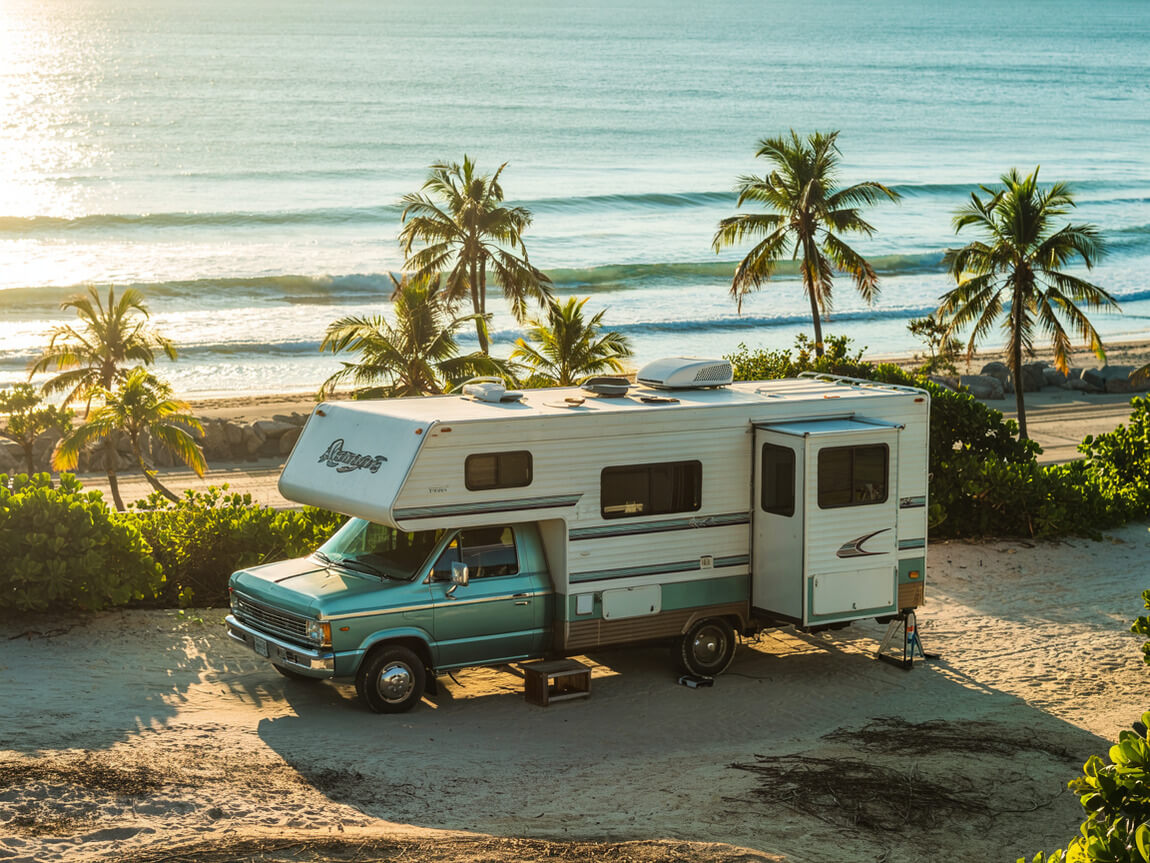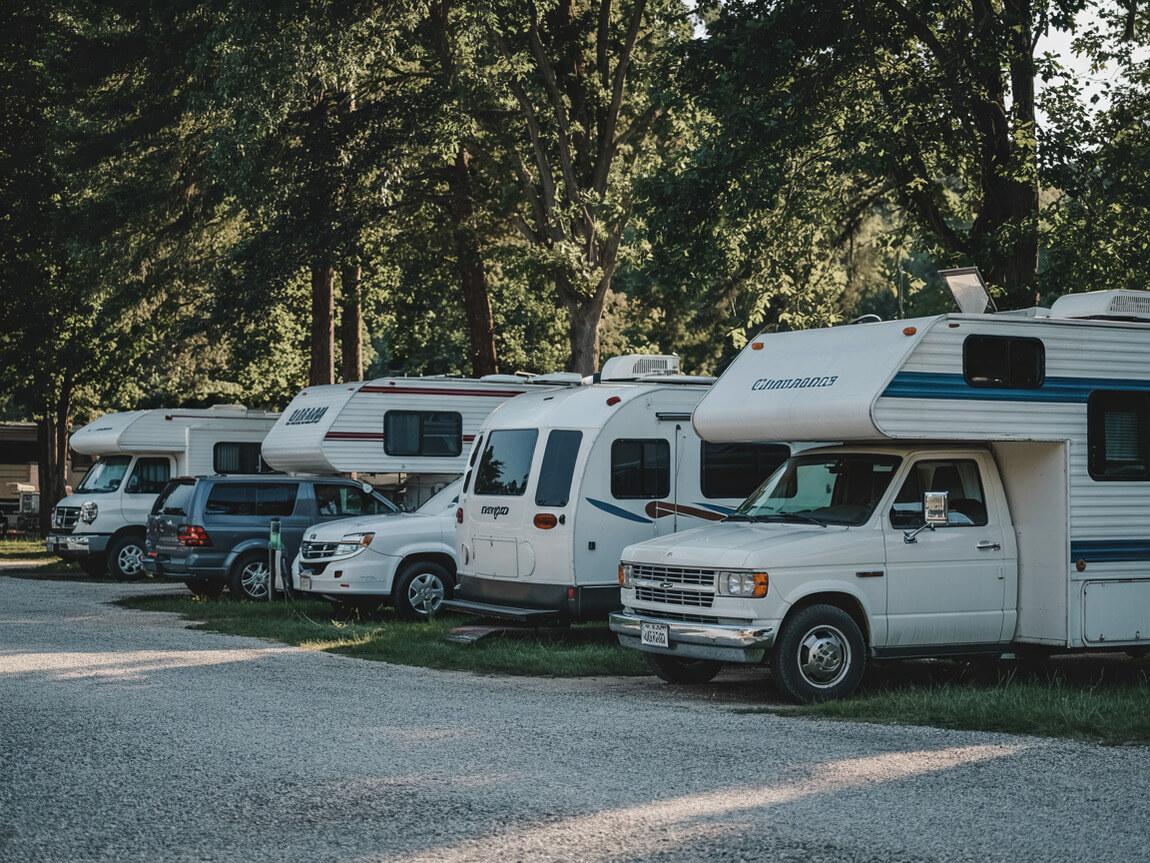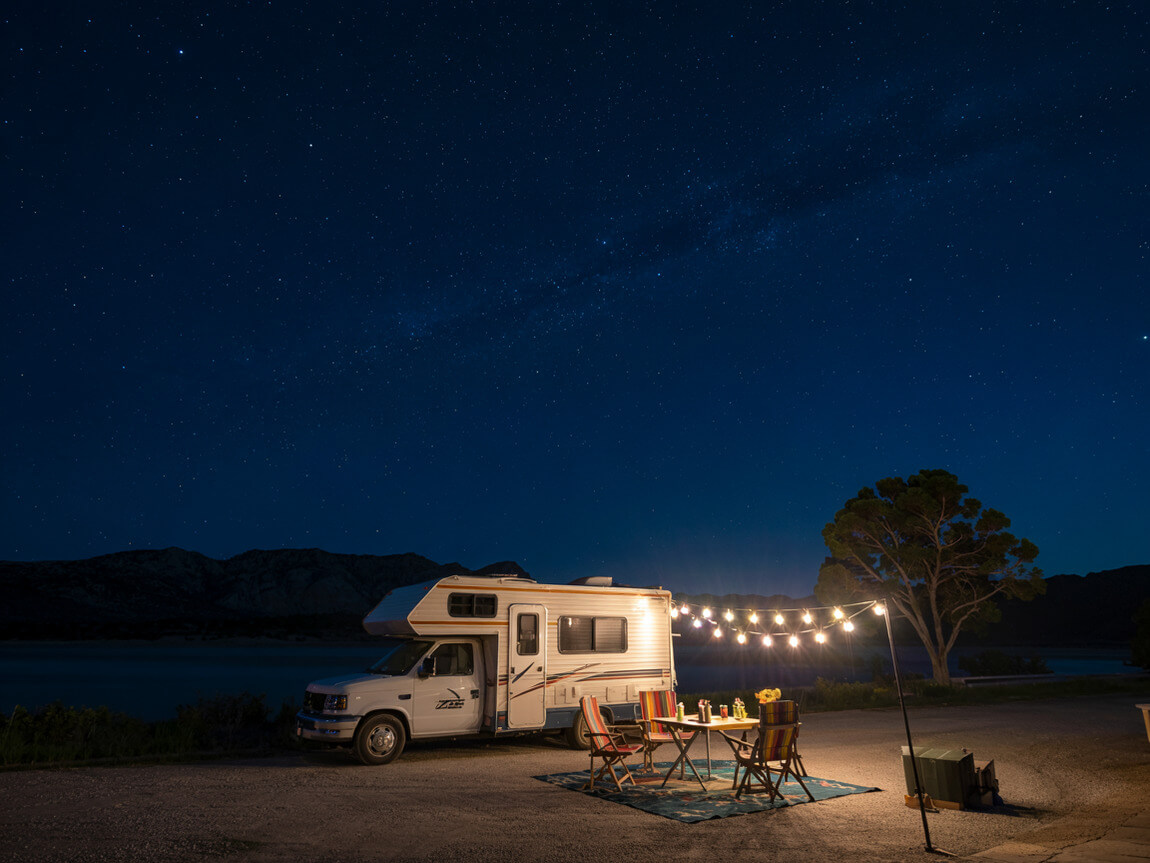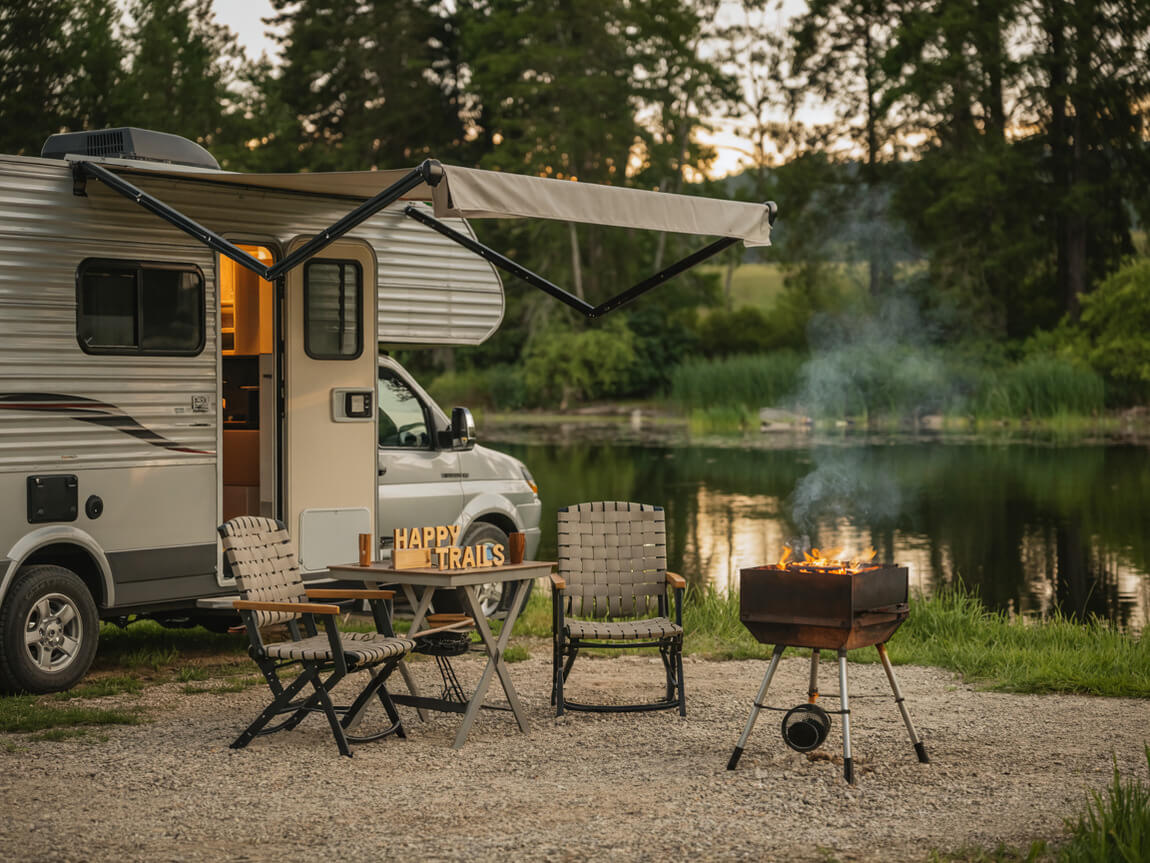Dreaming of trading your stationary home for life on the open road? Transitioning to full-time RV living is exciting but requires careful planning to avoid costly mistakes and unnecessary stress.
Here’s what you need to do to get ready.
1. Choose The Right RV

As much as those giant Class A motorhomes look amazing, there’s something to be said for finding the RV that actually fits your lifestyle.
The perfect rig depends entirely on how you plan to travel. Moving frequently? A motorhome saves the hassle of unhitching every time.
Planning longer stays with day trips? A towable RV with a separate vehicle for exploration makes more sense.
The best approach is trying before buying. Rent different types of RVs for weekend trips. It’s worth spending a few hundred dollars on rentals to avoid spending thousands on the wrong RV later.
2. Make A Realistic Budget
Let’s talk about money. Full-time RVing isn’t cheap, but it doesn’t have to break the bank either.
The budget needs to cover both upfront costs and monthly expenses. That fancy $80,000 RV might look tempting, but perhaps the $45,000 model leaves more cushion for actually enjoying life on the road.
Monthly expenses vary wildly depending on travel style. Boondocking on public lands? Expect to spend far less than someone hopping between luxury RV resorts.
Don’t forget to budget for the fun stuff too. After all, what’s the point of traveling if there’s no money left to actually experience the places visited?
3. Inspect RVs Before Buying

RV salespeople can be as smooth-talking as any car dealer, but don’t get swept away by pretty interiors and fancy features. A thorough inspection is non-negotiable.
Water damage is the biggest enemy. Check every ceiling corner, around windows, and under sinks for stains, soft spots, or musty smells.
Test absolutely everything that can be tested. That fancy fireplace? Turn it on. All the lights? Flip every switch. The shower? Run the water.
Walking away from a problematic RV might feel disappointing in the moment, but it’s nothing compared to discovering major issues in the middle of nowhere three months into the journey.
4. Find Remote Sources Of Income (If Needed)
The days of having to be a retired millionaire to enjoy full-time RV life are thankfully over. Remote work has exploded, opening endless possibilities for earning while traveling.
The trick is setting up income streams before hitting the road. Trying to figure out work while also learning to dump tanks and navigate campground reservations is a recipe for stress.
Many successful full-timers combine multiple income sources. Perhaps a part-time remote job, some freelance gigs, and occasional workamping at campgrounds.
The most important factor isn’t actually how much money comes in, but having predictable, stable income that doesn’t require constant internet connections or specific locations.
5. Research Health Insurance
Healthcare might not be the sexiest topic when dreaming about sunsets and mountain views, but ignoring it can derail the entire adventure.
Traditional insurance plans often function poorly for nomads who cross state lines regularly. Nationwide PPO plans exist but can be pricey. Health share ministries have become popular with many full-timers as an alternative.
The explosion of telehealth services has been a game-changer, allowing video appointments from almost anywhere with decent cell service.
Don’t forget about dental and vision care either. Finding a random dentist in an unfamiliar town during an emergency is both stressful and expensive.
6. Get A Mail Forwarding Service
Even in this digital age, physical mail remains an annoying necessity. Mail forwarding services solve this problem by providing a permanent address (often in tax-friendly states like South Dakota, Texas, or Florida) and handling mail according to instructions.
The best services scan envelope exteriors so users can decide whether items should be forwarded, opened and scanned, shredded, or held.
Before hitting the road, it’s worth spending a few hours switching everything possible to paperless delivery. Every piece of mail that never gets sent in the first place is one less thing to manage while traveling.
Plus, fewer trees sacrificed for unwanted credit card offers is always a good thing.
7. Decide What To Do With Your Home
The house question can actually be the most emotionally complicated part of transitioning to RV life. Selling means burning bridges to the past but provides capital and true freedom.
Renting creates passive income but also means being a long-distance landlord (or paying a management company). For those uncertain about full-time RV living, keeping the house for the first year provides a safety net.
The “right” decision varies for everyone, but it’s worth considering long-term plans. If returning to the same area in a few years seems likely, housing markets might make keeping the property financially smart.
If the goal is permanent nomadic living, the simplicity of selling often wins out.
8. Downsize Your Belongings
Nobody realizes how much stuff they’ve accumulated until they try fitting their life into 300 square feet on wheels. The downsizing process is always more time-consuming and emotionally draining than expected.
Start early. Like, months early. Attack the process room by room with four categories: keep, sell, donate, and trash.
Be ruthlessly honest about what actually gets used regularly. Those “just in case” items? They rarely justify their storage space.
For sentimental objects that won’t make the cut, taking photos often provides the emotional connection without the physical burden. The process feels painful at first but becomes oddly liberating as it progresses.
9. Organize Important Documents
Paperwork might be boring, but having organized documents prevents massive headaches down the road. Gather everything important. Vehicle titles, insurance policies, passports, birth certificates, medical records, and pet vaccination records.
Create digital copies by scanning everything, then store them securely in cloud storage accessible from anywhere. Keep physical originals in a compact, water-resistant file box inside the RV.
Developing a simple system for managing ongoing paperwork like campground receipts and maintenance records saves time and frustration later.
Tax season becomes much less stressful when all the necessary documents are already organized rather than scattered across various storage compartments.
10. Purchase The Necessary RV Gear

Shopping for RV gear can quickly spiral out of control. There are gadgets for literally everything.
Start with true essentials: quality drinking-water hose, water pressure regulator, sewer hose kit with clear elbow (to see when tanks are truly empty), and electrical adapters.
Add leveling blocks, wheel chocks, and basic tools for setup and minor repairs. A good emergency kit with roadside reflectors, jumper cables, and first aid supplies is non-negotiable.
Everything else? Wait until actually living the RV life to discover what’s truly needed. Those fancy organizing systems and custom accessories can wait until real-world experience reveals which ones would genuinely improve daily life.
11. Have An Internet Plan
In today’s connected world, internet access isn’t a luxury. It’s a necessity, especially for remote workers.
Most full-timers rely on cellular data plans as their primary connection. Getting plans from two different carriers offers better coverage as one often works when the other doesn’t.
A cell booster can work wonders in marginal coverage areas. Having backup options for when cellular fails like a list of libraries, coffee shops, or co-working spaces with reliable WiFi prevents panic when important deadlines loom.
Test the setup thoroughly before depending on it for work. Nothing ruins the peaceful RV lifestyle quite like stressing about internet connectivity while parked in beautiful but remote locations.
12. Familiarize Yourself With New Camping Spots
The camping world offers far more variety than most people realize. Luxurious RV resorts with pools and activities sit at one end of the spectrum, while peaceful public lands with free camping occupy the other.
Each type comes with trade-offs in amenities, cost, atmosphere, and accessibility. Campground finder apps like Campendium, iOverlander, or The Dyrt make finding options much easier.
State parks often provide the sweet spot. Reasonable prices, beautiful settings, and basic amenities. National forests and BLM lands offer free camping but usually without hookups.
Most full-timers develop a mixed approach, perhaps boondocking for a week or two before hitting an RV park for laundry, unlimited showers, and fast WiFi.
13. Consider A Camping Membership

Smart travelers know that membership programs can transform an expensive habit into an affordable lifestyle.
Passport America offers 50% off at participating campgrounds. The membership often pays for itself in just a few nights. Harvest Hosts provides unique overnight experiences at farms, wineries, and museums for the cost of a yearly membership (and often a courtesy purchase from the host).
Thousand Trails works well for those planning longer stays in specific regions. For public lands enthusiasts, the America the Beautiful pass grants access to national parks and federal recreation areas for a year.
The key is analyzing typical travel patterns. Even seemingly expensive memberships can create massive savings when they align with preferred camping styles.
14. Learn How To Set Up Your RV & Do A Trial Run
Nothing exposes RV issues quite like actually using it. Before committing to full-time living, take the rig on a “shakedown cruise” near home.
This trial run reveals problems or missing gear while still close to familiar resources. Create simple checklists for arrival and departure procedures to avoid forgetting critical steps like retracting the antenna or unplugging shore power.
Practice backing up in an empty parking lot if that skill needs work. Learn how the electrical, water, propane, and waste systems function and how to troubleshoot basic issues.
The goal isn’t to master everything immediately. It’s identifying knowledge gaps while help is still easily available. Plus, the trial run provides practice organizing storage spaces efficiently.
15. Practice Good RV Etiquette
Entering the RV community means understanding some unwritten rules that help everyone enjoy shared spaces.
The golden rule? Respect quiet hours (typically 10pm to 8am) by keeping noise down and not running generators. When arriving at a campsite, stay within the designated space without sprawling into neighboring sites.
Keep pets under control and clean up after them promptly. Always leave campsites cleaner than they were found.
These simple courtesies create goodwill among fellow RVers and with campground owners. The RV community can be incredibly helpful and welcoming to those who respect the culture. That friendliness often translates to invaluable tips, helping hands during difficulties, and even unexpected friendships that enhance the journey.


